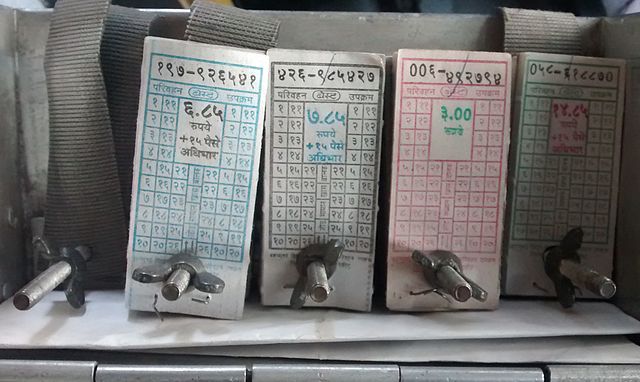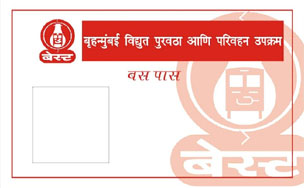Electronic Ticketing Systems are commonly used now-a-days. Here, we take a look at the various aspects of Electronic Ticket Systems, and how they fare compared to Manual Fare Collection systems.
Before we delve into the world of ETMs, let us begin with Manual Fare Collection in different parts of the country and how things were different then.
Manual fare collection systems have been prevalent in India for decades in different fashions. Trancsos like BEST, NMMT, PMPML, MSRTC have had standard punched tickets, while their southern counterparts like BMTC, KSRTC, MTC, TNSTC have similar looking tickets, though they may not be punched.

What did Manual ticketing entail for the conductor as well as the commuter?
- Different tickets with different denominations had to be printed, serial numbers had to be stamped and then delivered to the depots, from where they’d be handed over to the conductors. Now this would have hardly been an issue with Transcos like NMMT and TMT who have just 2 depots each, but it becomes a headache for larger ones like BEST or BMTC with 26 and 43 depots respectively. The problem is compounded when it comes to State level transcos as well.
- What if the conductor runs out of a particular denomination? If it is a larger denomination, I’m sure he’d be able to give it in smaller denominations like BMTC and TNSTC conductors have given me but what if it is the smallest denomination possible.
- The conductor has to remember stages for the entire route. Long-distance routes, become a pain in the neck.
- Trip-sheet maintenance was a herculean task for all conductors, they had to count the number of tickets sold, tally it with the money they got and get it approved by the Depot manager.
- It becomes a headache for the Ticket Examiner as he has to decipher the stage and fare in a bus full of people.
- If the passenger [like me] collects tickets and keeps a bunch of them in his or pocket, and the Examiner asks for your ticket, well, I was let off with a warning because I was 11.
- The upside of these tickets were that they were equivalent to Collectors items. While American kids grew up with Trading Cards at the same time, we grew up trading our bus tickets. They were colourful, had different numbers, and different punchmarks on them. Unless it is a PMPML ticket.
Now, let us make the transition to Electronic tickets.

My first interaction with Electronic Ticket Machines [ETMs] was in 2008 when I had shifted to Bangalore. BMTC was using the MicroFX BTM series at that time. These devices were used on various routes, mostly on Suvarna and Vajra services. These machines however, disappeared somewhere around the onset of 2011. Around 2010, I saw some MTC and mofussil routes of TNSTC use these machines on certain routes, as well. KSRTC [Karnataka] had deployed these machines in 2004, and by 2008, the entire on-board ticketing was done using ETMs. MSRTC too, today has implemented ETMs across Maharashtra, for both, on-board ticketing, as well as the off-board ticketing on their Shivneri and Hirkani routes.
Now, let us look at some of the benefits the ETMs have given our transcos. I have taken this from a Case Study on KSRTC by the World Bank and a Case Study on MSRTC by CIO.IN.
- The need to run a printing press to print tickets has gone. Along with it, the overheads of transport and running an entire accounts team to monitor the process is eliminated.
- Conductors no longer need to maintain a trip-sheet. The data is already on the ETM, so they just have to synchronise it with the Depot, either at the end of the day, or wirelessly on the fly.
- These systems allow the Corporation to monitor routes in real-time. This means that statistics and revenue details can be had for any route, at any given point in time, which helps in maintaining an efficient route network, eliminate overlapping routes, modify loss-making routes, and more.
Now, after all this, one would like to assume that whoever implemented ETMs would be better off than those who didn’t. Unfortunately, that isn’t the case. As is the case with most new ventures in India, a venture is only as good as its implementation.
Here are a few instances of problems:
- The PMPML, ended up scrapping its entire ETM range because they were unable to back up any of the data from it. The ETMs were failing as often as their buses.
- The BMTC scrapped its initial set of ETMs and then got a newer set later on.
However, only one organisation in India has taken full advantage of Electronic Ticketing Machines, and that is the BEST. The BEST, in 2011, decided to go the MRTC way by partnering with Trimax IT for its Electronic Ticketing System. As per the Trimax Case Study on BEST, the arrangement was made under a Build-Operate-Transfer (BOT) agreement where Trimax would supply the infrastructure needed and keep a percentage of the revenue generated.
So, what was the deal all about?
Well, here goes:
- All Ticket boxes were replaced with ETMs.
- All bus passes were replaced by RFID cards.
- Trimax set up a Server, which runs on Open-Source Software.
- Setting up an online payment system for Bus Passes.
- The all important ePurse.

The most important parts of this development were:
- Connecting a Bus Pass to the ID card
- The ePurse Concept.
In the last few years, several Transcos have insisted on an ID card for issuing Daily Passes to prevent their resale. BMTC started charging extra for passes if the commuter did not have a BMTC ID. BEST went one level ahead by saying a Daily Pass could only be bought if the user had an RFID card. This eliminated the need for manual verification and validation of both the ID as well as the pass. Simply scan under the ETM and it tells the Conductor whether a Pass has been issued or not.
The ePurse, on the other hand, is basically a prepaid card. It allows the holder to purchase upto 6 tickets at one go, and allows for any amount of tickets to be purchased, so long as there is a minimum of ₹50 balance on the card. The ticket that is printed, comes with the balance printed on it.
BESTs ETMs are connected to the servers via GPRS, thus keeping them in-synch, eliminating the need for conductors to transfer data manually. This also helps in sending announcements and notifications to the conductor and driver. When fares are revised, the ETMs automatically pick it up.
In order to do this, BEST had to create an entire database with the names of each bus stop, with their coordinates, routes that halted there and assigned each of them a unique ID. This ID can be found on the physical bus stop. It can be used to find out the Estimated Time of Arrival of a bus by sending BEST<space><Bus Stop ID> to 56060. Each bus is connected with a GPS unit that transmits data to the server.
Now all this may sound rosy, but to be honest, may not not work outside of BEST. It may not work with NMMT, TMT, PMPML, or BMTC. The reasons are:
-
-
- No fixed bus stops, especially in newer areas. Without fixed bus stops, it can’t be named and assigned an ID.
-
Specific BEST bus stops have specific buses stopping at them, some of the others don’t. Thus, there may be four Unipoles at a Bus stop, each with a different bus marked on it, each with a different ID.
Thus, I think it is clear that at the end of the day, BEST is indeed the BEST here. They have done a truly wonderful job with their system. MSRTC is close behind, with KSRTC just missing the real-time synchronisation. Other transcos, must try and catch up, or risk losing revenue due to leaks.
![]()
